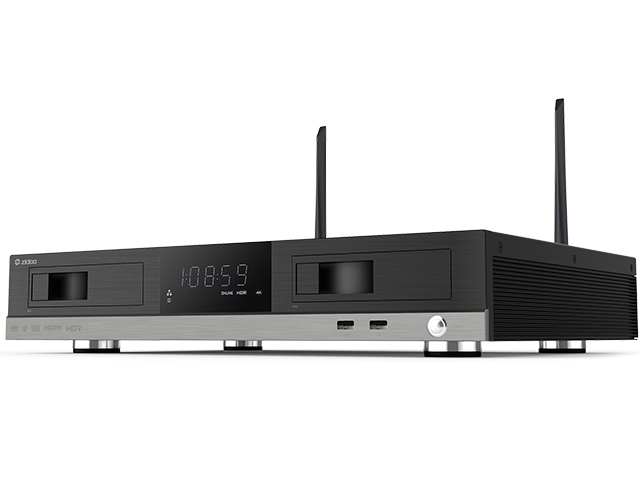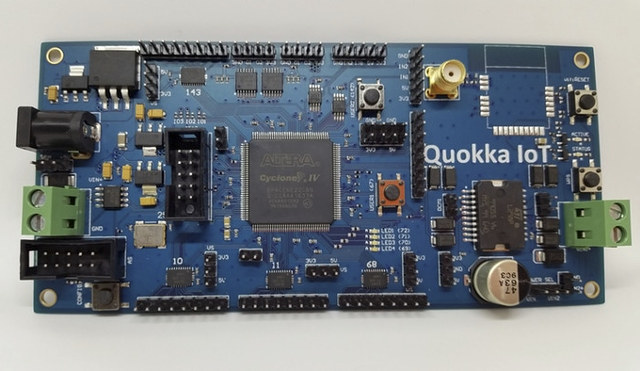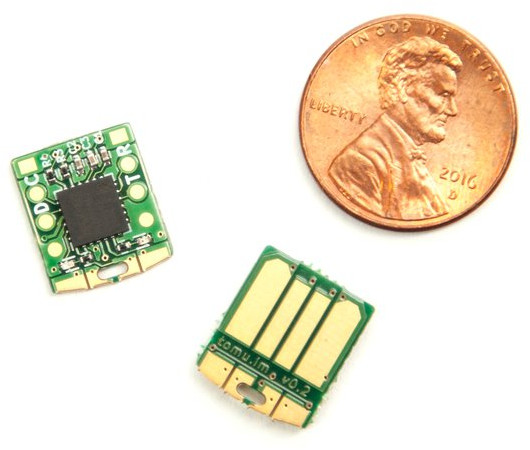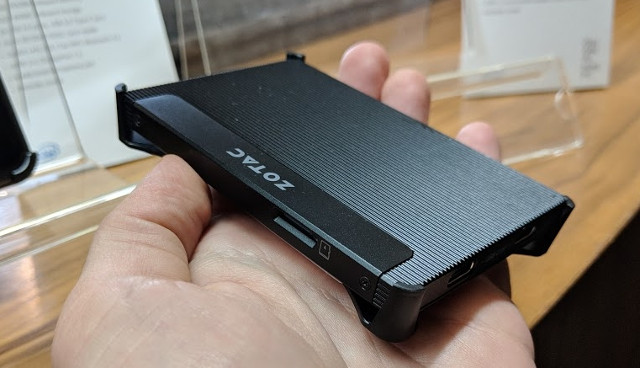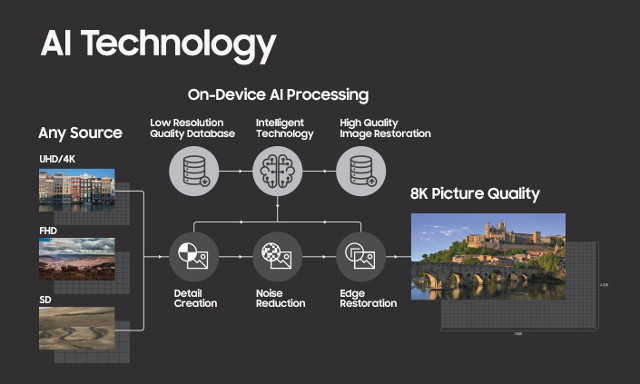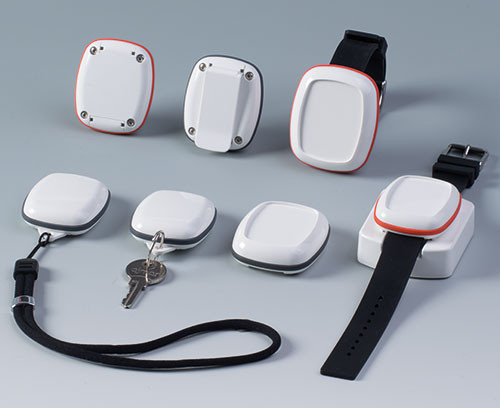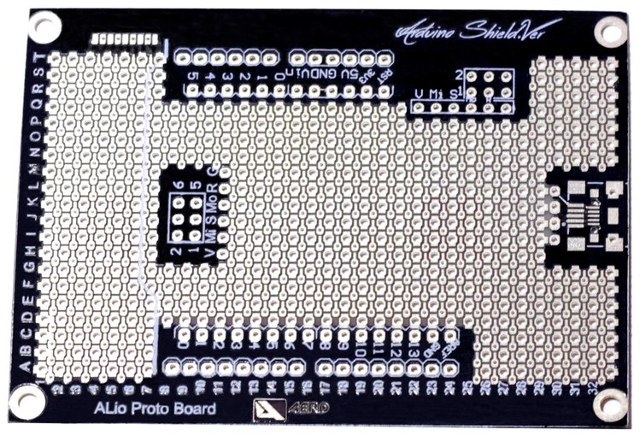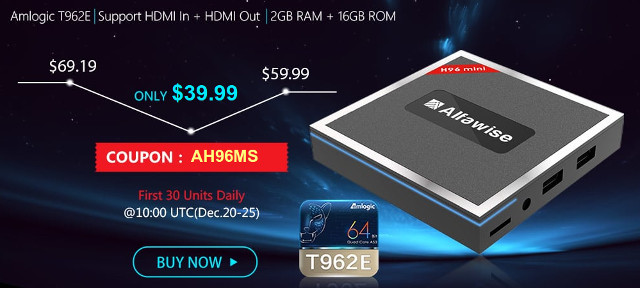Zidoo has some news for their Realtek RTD1295/RTD1296 powered devices such as Zidoo X8, X9S, or X10. First, the company will soon release a firmware update that includes Poster Wall 2.0, an app that display movie posters and information in a concise and eye-pleasing way. The company is also working on a higher-end player called Zidoo X20 Pro powered by RTD1296 expected to launch in a few weeks, once beta testing is complete, and firmware looks stable enough. Zidoo X20 Pro RTD1296 Media Player Zidoo X20 Pro specifications: SoC – Realtek RTD1296 quad core Cortex A53 processor with ARM Mali-T820 MP3 GPU System Memory – 4GB DDR4 Storage – 32GB eMMC flash, 2x SATA 3.0 bays for 2.5 or 3.5″ drives Video 2x HDMI 2.0a output ports with HDCP 2.2, 4K 60 Hz 1x HDMI 2.0 input with HDCP 2.2 supporting PiP, stream recording, and UDP broadcasting 1x RCA composite […]
Quokka IoT FPGA Board is Programmable with C# Language (Crowdfunding)
Quokka FPGA IoT Controller is a board based on Altera Cyclone IV FPGA with a WiPy module for connectivity, and various I/Os that allows you to make robotics projects for example. While you could program the FPGA using VHDL, the developer – Evgeny Muryshkin – also designed Quokka Development Toolkit (QDT), a cloud-based SaaS, allowing to program FPGA with a high-level programming language, currently C#, so that software people can more easily become involved in FPGA development. Quokka IoT (preliminary) hardware specifications: FPGA – Intel Altera Cyclone IV, 6K logic elements, EP4CE6E22C8 Clock – 50MHz Connectivity – WiFi via WiPy module Expansion 40x GPIO (3 banks by 8 pins, with direction and voltage (3.3V or 5V) configuration, 16 raw IO pins 3.3V) 2x Dual Channel 10 bit ADC (3.3V) 2x Dual Channel 10 bit DAC (3.3V) H-Bridge for DC motors with support for external power Power Supply – 5-24V DC input […]
Tomu Arm Board Fits into a USB Connector, Adds Buttons, Two Factor Authentication to Your Computer (Crowdfunding)
We’ve covered many boards that claim to be the world’s smallest development board, and Tomu board does not claim anything like that, but it’s pretty small, as it’s made to fit into your computer’s USB board. It may be cool, but it could also potentially be useful, as the board exposes two (capacitive touch?) buttons, and two LEDs so you can use it as a computer accessory for example to add volume buttons, or as a Universal 2nd Factor (U2F) token supporting two-factor authentication (2FA) to login to compatible online services. Tomu board hardware specifications: MCU – Silicon Labs Happy Gecko EFM32HG309 ARM Cortex-M0+ up to 25 MHz with 64KB flash, 8KB RAM USB – 1x USB 2.0 FS port Misc – 2x buttons, 2x LEDs: 2 (red + green) Dimensions – 1.4mm thick (0.6mm thick PCB) Singapore based Sutajio Ko-usagi – the company behind the project – provides the […]
ZOTAC ZBOX PICO PI226 & PI336 Gemini Lake Mini PCs Unveiled with Celeron N4000/N4100 Processor
ZOTAC is now showcasing their first Gemini Lake based mini PCs at CES 2018 with ZBOX PICO PI226 & PI336 models powered respectively by an Intel Celeron N4000 dual core processor, and Intel Celeron N4100 quad core processor. ZBOX ZBOX PICO PI226 The model is similar to ZOTAC PI225 reviewed by Linuxium a few weeks ago, and the company had to disable turbo mode in PI225 in order to keep temperature under control. The company placed it in the VESA mount for the event, and at first I though it may help with cooling, but Linuxium (see comments) tried with PI225, and heat dissipation was not improved. ZOTAC PI226 specifications: SoC – Intel Celeron N4000 dual core Gemini Lake processor up to 1.1/2.6 GHz with 12EU Intel UHD Graphics 600 @ up to 650 MHz; 6W TDP System Memory – 4GB LPDDR4 Storage – 32GB eMMC flash, micro SD card […]
Samsung 8K QLED TV Uses Artificial Intelligence to Upscale SD Content to 8K Resolution
You’ve probably read how artificial intelligence can be applying to modify photos, either repair them, or change the weather in photos from sunny to rainy, and vice versa. Samsung unveiled an 85″ 8K QLED TV right before CES 2018, which should be news by itself, but that I found really intriguing is the TV’s artificial intelligence capabilities that will upscale standard and other resolution content to 8K resolution. The TV will take SD, Full HD or 4K sources runs it through machine learning algorithm to re-create details, reduce noise, and restore edges to bring them back to 8K picture quality. Not your usual “dumb” upscaling 🙂 The TV is said to be equipped with a database that studies and analyzes millions of images in advance to transform low-resolution content into high-resolution, and capable of selecting the optimal filter to convert the source to higher quality. Samsung then explains the images […]
OKW Body Case is an IP65/IP67 Enclosure for Wearables & IoT Projects
You may have worked on a battery powered wearable or IoT projects, and the hardware and software are mostly ready, but you’ve yet to find a good way to package it to make it easily wearable, and protect it from the elements. OKW body case could be one way, as it can be used around your arm like a wrist watch, as a key ring attachment, clipped to your trousers or T-shirt, carried around your neck. The case has been moulded in ASA plastic with a high UV protection, includes a TPV sealing ring to ensure IP65/IP67 water & dust proofness, and is assembled with four stainless stell screws using a Torx drive. The company provides two sizes (Large: 55 x 46 x 17 mm, or Medium: 50 x 41 x 16 mm) and claims easy operation with the help of push buttons or touchscreens, although I’d assume water / dust resistance […]
ALio Proto Board Supports Through Hole, DIP, and SMD Components (Crowdfunding)
Perfboards and stripboards are very useful to design your own simple electronic boards without having to design your own board from scratch. However, you have to select through hole or DIP components, as – while possible with some efforts – such boards are not designed for SMD components. AERD, an open source electronic development startup based in Indonesia, has designed ALio prototyping boards supporting both through hole and SMD components, as well as some common connectors/accessories such as micro SD card, USB connector, and so on. Three versions of the board (basic, embedded, Arduino) are available with the following specifications & features: Fits SMD and PTH components at the same time. Double layer bus (top and bottom) Other components/headers All versions – 1.1 mm pitch pad for micro SD/SD card breakout Embedded & Arduino only – mini & micro USB pads, 1x SPI breakout Arduino only – Arduino header, one […]
H96 Mini TV Box with HDMI Input Sold for $40 (Promo)
H96 Mini is a TV Box powered by Amlogic T962E quad core Cortex A53 processor that supports both HDMI output and input. When I first covered the device, it was not very clear what was possible with the HDMI input port on this particular device, and I’ve just got a confusing answer from GearBest, which implies video recording may not be working yet, or may it is… The device was first launched for about $55 in October, and the good news is that you can now purchase it for $39.99 with coupon AH96MS. The bad news is that price is only available during daily flash sale, where 30 units are offered at 10:00 UTC until December 25, so you’d have to be right in time to get the deal. Maybe with the 30 units available per day, it will be easier than some other flash sales with a lower number. […]


